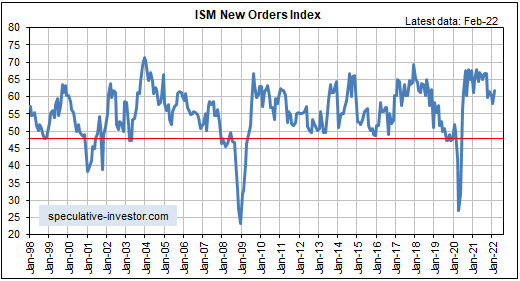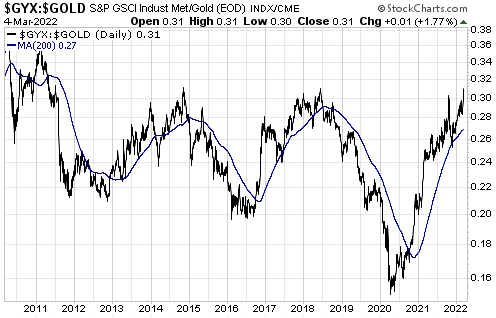[This blog post is an excerpt from a commentary published at TSI on 6th March 2022]
The latest leading economic data indicate that the US expansion is intact. This is the case even though the following monthly chart reveals that the ISM Manufacturing New Orders Index (NOI), one of our favourite leading economic indicators, has been working its way downward since hitting a cycle peak about 12 months ago. The reason is that it’s normal for the rate of improvement — which is what the NOI is measuring — to decline while the economy remains in the expansion phase. That being said, we’ve noted over the past two months that the pace of US economic activity is set to slow markedly during the first half of this year.

We wrote a month ago that due to “inflation” remaining near its cycle peak while the pace of economic activity slows, the ‘real’ GDP growth rate during the first quarter of this year could be close to zero. That was before Russia attacked Ukraine and the West imposed severe economic sanctions on Russia, causing additional large increases in commodity prices. As a result of these price increases, the official “inflation” statistics such as the CPI will be higher for longer and calculations of ‘real’ growth will be lower. This could well mean that the headline US GDP growth numbers will be negative in both Q1-2022 and Q2-2022.
Note that a sign of the downward pressure on economic activity resulting from high inflation is the decline in ‘real’ wages. The monthly US Employment Report issued on Friday 4th March contained an estimate that hourly earnings had increased by 5.1% year-over-year in nominal dollar terms. While this is high compared to the average of the past two decades, it’s likely that the cost of living increased by 8%-12% over the same period. This implies that real hourly earnings have fallen by at least a few percent over the past 12 months.
Will the Powell-led Fed make a series of rate hikes in the face of a shrinking economy in response to price rises that are due to supply disruptions? We don’t think so. A Volcker-led Fed would have begun hiking interest rates long ago, but “Mississippi Jay” is the most dovish Fed chairman ever. The Fed almost certainly will make a 0.25% rate hike this month, but we continue to suspect that it will then go on hold for the remainder of the year.
At this stage the leading recession indicators we follow do NOT point to a recession beginning within the next six months (two quarters of negative GDP growth can occur in the absence of a recession), but there’s now a high probability that a boom-to-bust transition will begin during the first half of this year. The recent widening of credit spreads is warning that this is the case, but to confirm a boom-to-bust transition the credit-spread widening will have to be joined by a downward trend reversal in the GYX/gold ratio (the Industrial Metals Index relative to the US$ gold price) and/or a downward trend reversal in the 2-year T-Note yield. The chart displayed below shows that the GYX/gold ratio ended last week at a multi-year high and near the level at which it peaked in 2014 and 2018.
As noted in previous TSI commentaries, the start of a boom-to-bust transition usually precedes the start of an official recession by at least a few quarters.

 Print This Post
Print This Post
